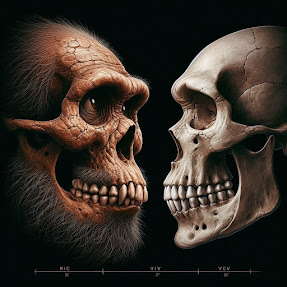They are extremely important
species for the study of human evolution as they were the first bipedal
primates, i.e. to walk on their hind legs. Australopithecus are considered to
be the first hominids and direct ancestors of the human genus.
However, Australopithecus did not only inhabit southern Africa, nor is it an ape. Over time, Australopithecine fossils were found in present-day Ethiopia, Chad, Kenya, Tanzania and South Africa.
Australopithecines had long,
sturdy arms, similar to those of apes, indicating that they combined movement
on their lower limbs with climbing trees or climbing among branches.
They were small and slender, with a height of between 1.20 and 1.40 metres. Sexual dimorphism in their species was quite pronounced: the male could reach 50% larger than the female.
Homo sapiens are indisputably those with the anatomical characteristics of present-day human populations. The oldest remains attributed to Homo sapiens, dated to 315 000 years ago, were found in Morocco. The oldest evidence of modern behaviour is from Pinnacle Point (South Africa), 165 000 years old.
It belongs to the genus Homo, which was more diversified and during the last 1.5 million years included other extinct species. Since the extinction of Homo neanderthalensis 28 000 years ago, it is the only known surviving species of the genus Homo.
Until recently, biology used a trinomial name - Homo sapiens sapiens - for this species, but more recently the phylogenetic link between Neanderthal and present-day humanity has been discarded and the binomial name is used exclusively. Homo sapiens belongs to a lineage of primates, the hominoids. Although the discovery of Homo sapiens idaltu in 2003 would make it necessary to return to the trinomial system, the taxonomic position of the latter is still uncertain. Evolutionarily it diverged in Africa and from that ancestor arose the family of which the hominids are a part. Inquiry link
The skulls of Australopithecus and Homo sapiens exhibit several profound differences that reflect the evolutionary journey from early hominins to modern humans:
Brain Size and Cranial Capacity:
Australopithecus: Australopithecus had a smaller brain size, with a cranial capacity ranging from about 400 to 550 cubic centimeters. Their brains were smaller and more ape-like compared to Homo sapiens.
Homo sapiens: Homo sapiens have a significantly larger brain size, with an average cranial capacity of around 1400 cubic centimeters. This larger brain size indicates increased cognitive abilities and advanced neurological development.
Skull Shape and Features:
Australopithecus: Australopithecus had a more elongated skull compared to Homo sapiens. Their skulls often featured a prominent brow ridge and a more prognathic (protruding) face. The cranial bones were thicker and more robust.
Homo sapiens: Homo sapiens have a rounder skull with a high, vertical forehead and a less pronounced brow ridge. The face is less prognathic and more vertical. The cranial bones are thinner and less robust, reflecting a reduction in overall skull size and a more gracile (less robust) cranial structure.
Dental Features:
Australopithecus: Australopithecus had larger teeth relative to their body size compared to Homo sapiens. Their molars were larger and more suited for grinding tough plant material.
Homo sapiens: Homo sapiens have smaller teeth, especially the molars, which are adapted for a more varied diet that includes cooked food and meat. This reflects changes in dietary habits and tool use over time.
Foramen Magnum Position:
Australopithecus: The foramen magnum (the opening in the skull through which the spinal cord passes) is positioned towards the back of the skull in Australopithecus. This positioning suggests a bipedal stance but with some adaptations for climbing and arboreal activities.
Homo sapiens: In Homo sapiens, the foramen magnum is positioned centrally under the skull, reflecting fully upright bipedal locomotion and adaptation to terrestrial environments.
Cultural and Behavioral Implications:
Australopithecus: Australopithecus species were primarily herbivorous and likely had limited tool use compared to Homo sapiens. Their cognitive abilities and social structures were less complex.
Homo sapiens: Homo sapiens exhibit advanced cognitive abilities, complex social structures, and sophisticated tool-making techniques. They have developed language, symbolic thinking, and cultural practices that have allowed them to adapt and thrive in diverse environments globally.
Human Evolution - Hominid Skulls - The Australian Museum
Homo sapiens – modern humans - The Australian Museum





Comments
Post a Comment